Nothing completes a homemade soup or salad like a sprig of aromatic parsley fresh out of the garden. Low-maintenance once established, this often finicky herb does take a bit of patience to get started.
Whether you live in a warm climate and you’re eager to sow directly into the garden, or you live in a cold zone with a shorter growing season and you’re eager to get a jump on the preparations to provide a springtime bounty, our guide can help.

We link to vendors to help you find relevant products. If you buy from one of our links, we may earn a commission.
Read on to discover our top tips to successfully start parsley from seed.
What You’ll Learn
Is It Hard to Grow Parsley from Seed?
Not at all! But you may need to be patient at first, to get the results you’re looking for.
Parsley is known for being a bit difficult to get started, with a less than stellar germination rate. But with our tips, you’ll be well on your way to producing a successful harvest.

While it’s quick and easy to grab a bunch of fresh herbs from the store, how many times have you done this and used exactly what you needed in a recipe, only to leave the rest to rot in the bottom of the fridge after you forgot it was there?
When you grow your own, there’s no unnecessary waste, and you can save money, too.
Packets of seeds are easy to obtain, and affordable. Mature plants can even be allowed to overwinter, so you can start harvesting seeds of your own for planting the following season.
If you produce more than you’re able to use right away, fresh parsley can be dried in a low oven or dehydrator, or blended into pesto and other sauces and frozen for later use.
Anything that remains beyond that, you can feel free to toss on the compost pile, to help provide nutrients for future generations of plants.
How Long Does It Take to Grow Parsley from Seed?
Parsley is a biennial, typically grown as an annual in Zones 3 through 9.
In warmer zones, it will grow through the winter, and you have the option to save your own seed as mentioned above, after the plants bloom. We’ll go into a little more detail about how to do this below, so keep reading!
Parsley seeds generally take about 14 to 28 days to germinate, with a variable germination rate.
After the seedlings sprout, as long as your plants are provided with the conditions that they prefer, you can expect to be able to start picking in about eight weeks.
Direct Sowing Tips
To direct sow, find a sunny spot that receives at least six to eight hours of sunlight per day. The soil must be well-draining and rich in organic matter – amend it if you need to.
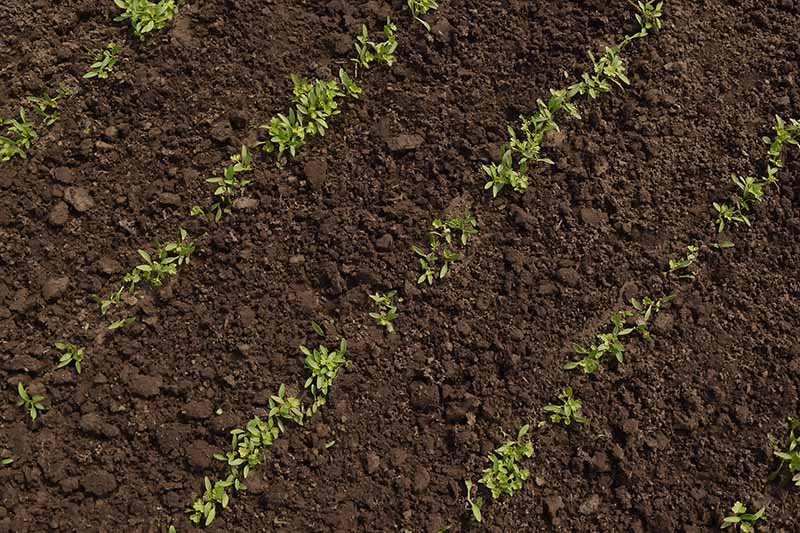
When selecting your location, also keep other plants in the vicinity in mind.
While trees and other perennials have not leafed out yet this early in the season, it’s important to note areas where they may cast shade on your garden plots later in the year, and plan accordingly.
Broadcast the seeds, covering them with a thin quarter-inch layer of soil. Alternatively, you can plant a few seeds per inch in straight rows, spacing each row about a foot apart.
Keep the soil moist until germination occurs. This may take several weeks.
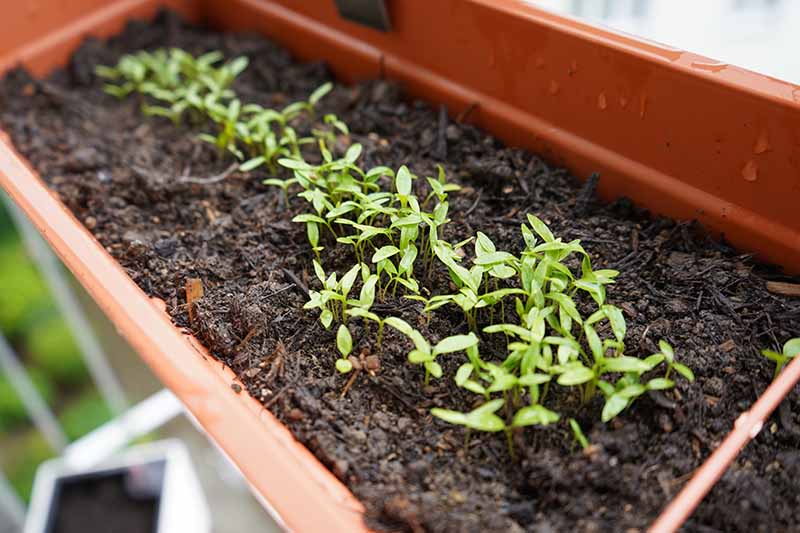
Continue watering regularly until the plants are well established. Once the seedlings are a few inches tall, you can thin them to eight inches apart.
Any that you pull or snip will make a tasty garnish or addition to a salad, or you can toss them on the compost pile.
To learn more about growing and caring for parsley, be sure to check out our complete guide.
Tips for Starting Indoors
Parsley has sensitive roots, so transplanting tends to be a bit tricky. This being said, starting seeds indoors can be a good choice for gardeners in cold climates with short growing seasons.
Start indoors six to 10 weeks before the average last frost date, and plant seeds in one- or two-inch pots or plug trays in a general potting or seed-starting mix.
Using biodegradable pots can help to reduce transplant shock, since you can stick them directly in the ground when you’re ready to transplant.
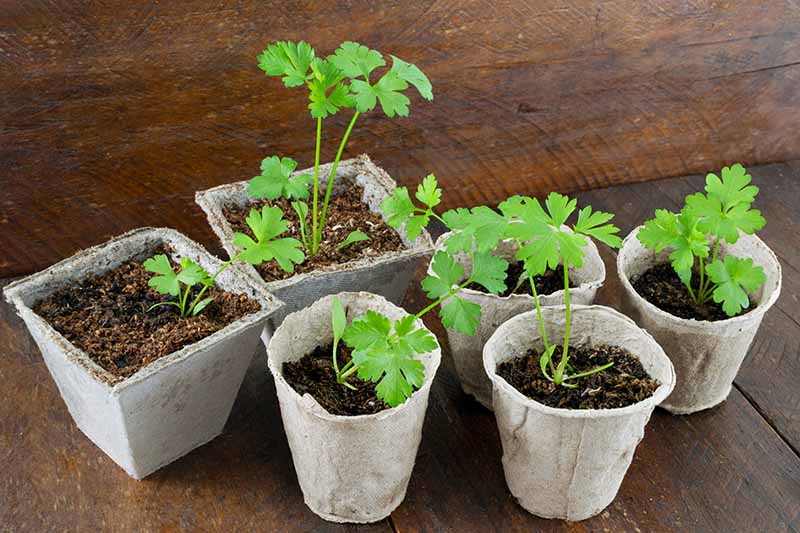
Plant at least a few seeds per pot and plan to thin them later. Since germination can be sporadic, planting more than you think you’ll need is the way to go. Cover lightly, burying them only an eighth- to a quarter-inch deep.
Parsley seeds will germinate in soil that’s anywhere between 50 and 80°F, though soil temperatures around 70°F are ideal. Germination tends to be slow, typically taking two to four weeks, or even six weeks in cooler temperatures.
While patience is key here, there are a few ways to help speed things up and actually improve germination rates.
Soaking seeds overnight prior to planting may help them to sprout faster.
Placing trays on top of a heat mat with a humidity dome placed over the top will also help to speed up the process. Once seedlings have sprouted, remove the humidity dome to increase airflow.
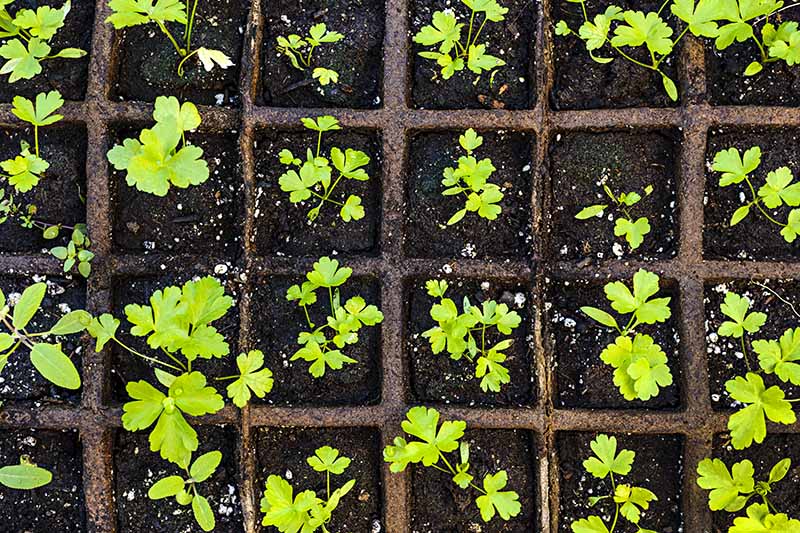
Keep the soil evenly moist until germination occurs. Continue watering seedlings as they grow to maintain soil moisture, but take care not to let the soil become soggy.
Seeds do not require light to germinate, but once sprouts appear, be sure to set the trays in a sunny window or under a grow light.
Since parsley tends to reach for the light and become leggy, it may be a good idea to use a grow light when starting indoors. Set lights two to three inches above the tops of the foliage once sprouts appear, and keep them on a timer for 12 hours a day.
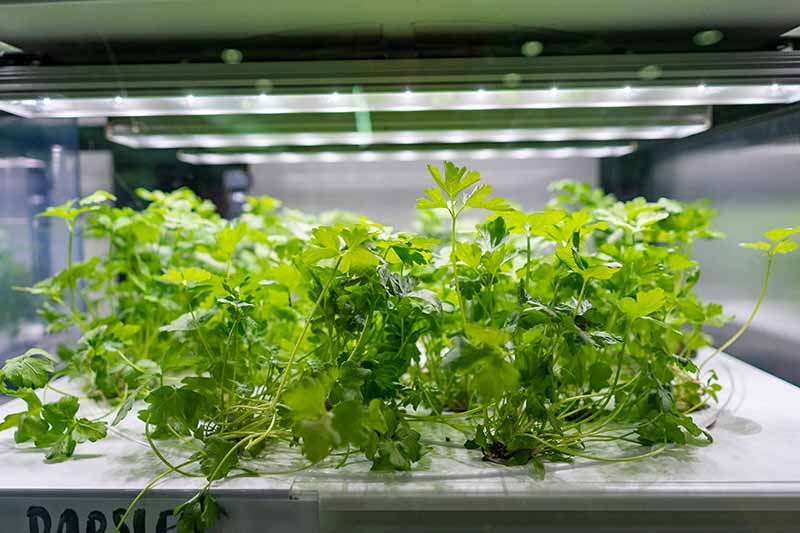
Once seedlings are a few inches tall, thin to one per pot or cell.
A couple of weeks before you are ready to plant outside, be sure to harden off your seedlings. This important step will help to prepare fragile plants for the harsher conditions of the outdoors.
To do this, simply set them outside for increasing lengths of time over the course of a couple weeks.
On the first day, set plants in a shaded location for an hour. Each day thereafter, gradually increase the length of time and exposure to direct sunlight and wind.
After a week or two of hardening off, they should be ready to transplant out to their final locations in the garden.
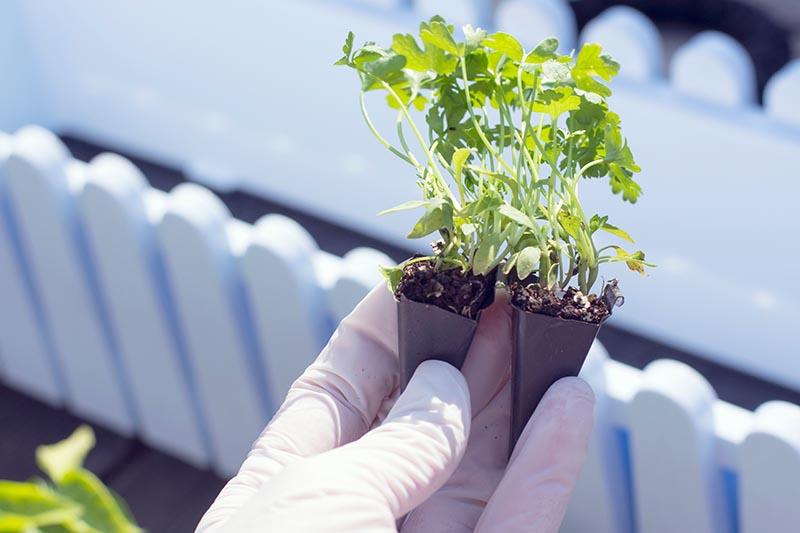
Transplant into rich garden soil, no earlier than a few weeks before the average last frost date in your area.
Dig holes the same depth as the pots, taking extra care when transplanting to avoid harming the roots. If using biodegradable pots, you can plant the entire pot directly into the soil, thus greatly reducing the risk of transplant shock.
Space them about eight inches apart, and at least eight inches away from other plants and structures as well. Parsley can also be grown in containers.
What Is the Fastest Way to Germinate Parsley Seeds?
To recap, keep the following pointers in mind to ensure quick and successful germination:
Use Fresh Seed
Seeds have an expiration date, and it’s best to start fresh each season to ensure quick and reliable germination.
Though seed storage banks can preserve seeds indefinitely, it’s close to impossible to provide the same ideal conditions at home.
Check your seed packets for the packing date and recommended length of viability, and aim to plant what you purchase as quickly as possible, in the same season.
If you save your own, try to plant them all the following season. And don’t forget – seeds are perfect for sharing with family, friends, and neighbors!
Soak First
Soaking seeds first will help to soften the seed coats, coaxing them into germinating more quickly, and more readily.
Simply place what you plan to plant in a dish of warm water overnight, and they’ll be ready to go.
Plant More Than You Need
Planting more seeds than you think you’ll need can help to save time in the long run, since you won’t have to start over from scratch if the first batch fails to germinate.
Broadcasting seeds outdoors, or sowing a few in each pot, cell, or row, is recommended to get the results you’re looking for. And you can always thin out any extras later.
Maintain Soil Temperature
Ideally, you want to maintain a soil temperature of at least 70°F.
Whether it’s with a heat mat or by waiting to sow until you’re sure the average soil temperature has risen to this level, germination rates will improve and sprouts will appear more quickly under warm conditions.
Don’t go overboard either – temperatures that are too hot, or about 90°F and above, will serve to impede sprouting instead.
Maintain Soil Moisture
Imagine the texture of a well-wrung-out sponge – that’s about how wet the soil should be when you plant.
Moisture should be maintained consistently at this level to promote germination, without allowing it to become overly soggy.
Increase Humidity
Humidity is just as important as moisture in the quest to make those little sprouts appear, so be sure to place a humidity dome over your seed-starting trays, or wrap the pots in plastic to hold the moist air inside until you see them starting to poke their little baby leaves out.
Covers and wrap can be removed to check the soil moisture level, and to water as needed.
To avoid future problems with rot, be sure to remove any humidity coverings as soon as germination has occurred.
Can You Collect Seeds from Parsley?
Since parsley is a biennial, if you leave the plants in your garden through the winter, they will resume growth and go to seed in the second year.
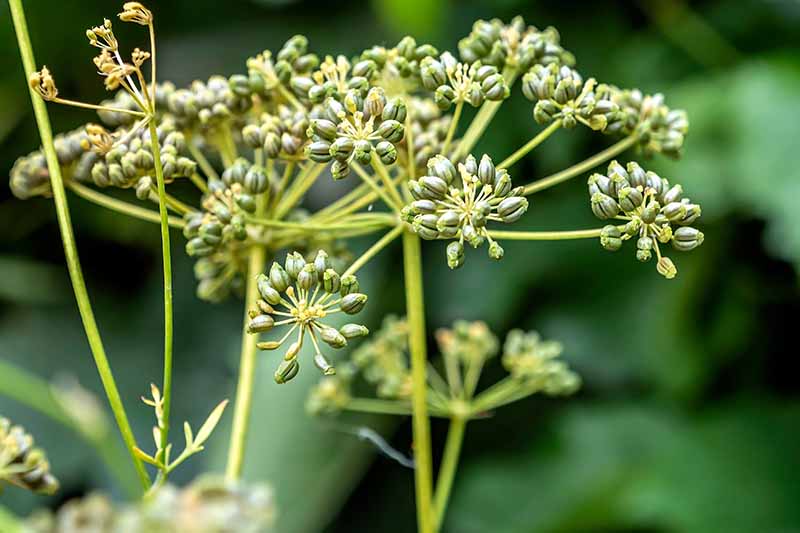
You can briefly bring in a harvest from second-year plants after growth resumes, but they will quickly bolt. I like to let a couple of plants go through this two-year cycle to save seeds for the following season.
To protect plants over the winter, cover them in a thick layer of straw or hay mulch in late fall, and remove it in early spring. See our guide for more tips.
Fresh Is Best
Starting parsley from seed may seem a bit finicky and slow, but with a little love and patience, it really is a breeze.
You can save money and reduce waste while enjoying the convenience of bountiful fresh parsley growing right outside your door.
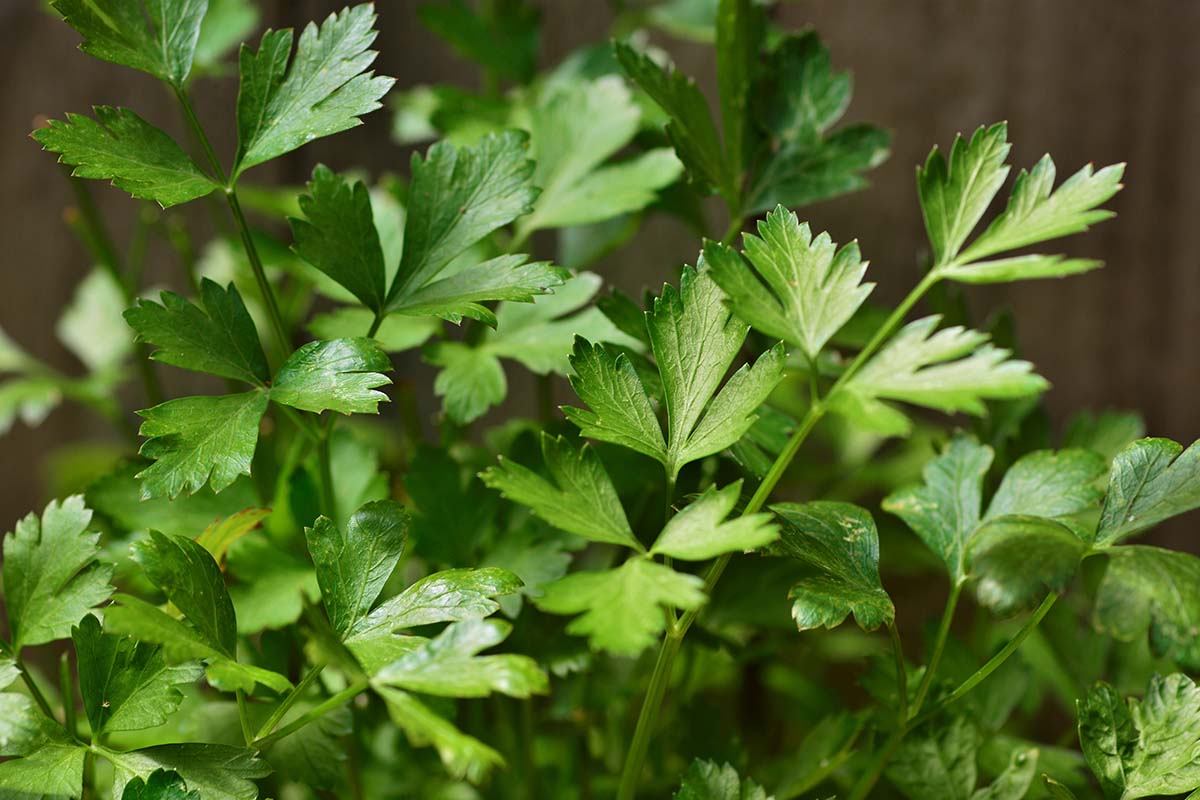
Just follow the simple steps outlined above and you will be garnishing your meals with sprigs of homegrown parsley all season long!
Have you successfully started parsley from seed? Share your tips in the comments below!
And to learn more about growing aromatic herbs in your garden, check out these articles next:
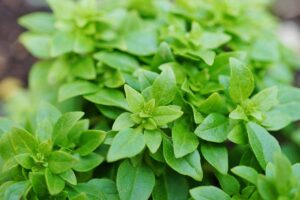
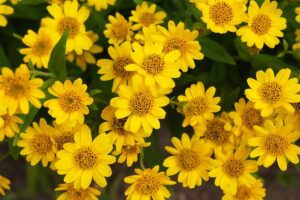

I hope you will add an article with growing tips for rooted parsley! You don’t even mention being able to grow such types, where you can eat the delicious roots 🙂
Hello Lye! That’s a great suggestion, for us to include more coverage of the parsley root (Petroselinum crispum), also known as Dutch or Hamburg parsley. Of course, its leaves are a bit more fibrous than the flat-leaf or curly varieties we typically enjoy, but harvesting parsley-flavored root vegetables can be worth the tradeoff. Thanks for reading, I’ll pass this suggestion along.